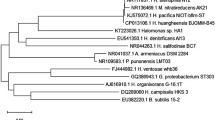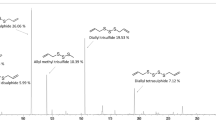Abstract
The antiviral metabolites from bacterial stress response to bacteriophage infection can maintain homeostasis of host cells, while metabolism disorder is a remarkable characteristic of tumorigenesis. In the aspect of metabolic homeostasis, therefore, the antiviral homeostasis-maintaining metabolites of bacteria may possess anti-tumor activity. However, this issue has not been addressed. Here we show that the homeostasis-challenged maintaining metabolites from deep-sea bacteriophage-challenged thermophile can suppress tumor metastasis. The results indicated that the metabolic profiles of the bacteriophage GVE2-infected and virus-free thermophile Geobacillus sp. E263 from a deep-sea hydrothermal vent were remarkably different. Thirteen metabolites were significantly elevated and two metabolites were downregulated in thermophile stress response to GVE2 infection. As an example, the upregulated L-norleucine was characterized. The data showed that L-norleucine had antiviral activity in thermophile. Furthermore, the in vitro and in vivo assays revealed that L-norleucine, as well as its derivative, significantly suppressed metastasis of gastric and breast cancer cells. L-norleucine interacted with hnRNPA2/B1 protein to inhibit the expressions of Twist1 and Snail, two inhibitors of E-cadherin, and promote the E-cadherin expression, leading to the inhibition of tumor metastasis. Therefore, our study presented that antiviral homeostasis-maintaining metabolites of microbes might be a promising source for anti-tumor drugs.
This is a preview of subscription content, access via your institution
Access options
Subscribe to this journal
Receive 50 print issues and online access
$259.00 per year
only $5.18 per issue
Buy this article
- Purchase on Springer Link
- Instant access to full article PDF
Prices may be subject to local taxes which are calculated during checkout






Similar content being viewed by others
References
Knight V, Sanglier JJ, DiTullio D, Braccili S, Bonner P, Waters J, et al. Diversifying microbial natural products for drug discovery. Appl Microbiol Biotechnol. 2003;62:446–58.
Lam KS. New aspects of natural products in drug discovery. Trends Microbiol. 2007;15:279–89.
Berdy J. Bioactive microbial metabolites. J Antibiot. 2005;58:1–26.
Xiong ZQ, Wang JF, Hao YY, Wang Y. Recent advances in the discovery and development of marine microbial natural products. Mar Drugs. 2013;11:700–17.
Gulder TA, Moore BS. Chasing the treasures of the sea-bacterial marine natural products. Curr Opin Microbiol. 2009;12:252–60.
Li X, Qin L. Metagenomics-based drug discovery and marine microbial diversity. Trends Biotechnol. 2005;23:539–43.
Salomon CE, Magarvey NA, Sherman DH. Merging the potential of microbial genetics with biological and chemical diversity: an even brighter future for marine natural product drug discovery. Nat Prod Rep. 2004;21:105–21.
Nastrucci C, Cesario A, Russo P. Anticancer drug discovery from the marine environment. Recent Pat Anticancer Drug Discov. 2012;7:218–32.
Pelaez F. The historical delivery of antibiotics from microbial natural products--can history repeat? Biochem Pharmacol. 2006;71:981–90.
Simmons TL, Coates RC, Clark BR, Engene N, Gonzalez D, Esquenazi E, et al. Biosynthetic origin of natural products isolated from marine microorganism-invertebrate assemblages. Proc Natl Acad Sci USA. 2008;105:4587–94.
Cairns RA, Harris IS, Mak TW. Regulation of cancer cell metabolism. Nat Rev Cancer. 2011;11:85–95.
Bristow RG, Hill RP. Hypoxia and metabolism. Hypoxia, DNA repair and genetic instability. Nat Rev Cancer. 2008;8:180–92.
Cairns R, Papandreou I, Denko N. Overcoming physiologic barriers to cancer treatment by molecularly targeting the tumor microenvironment. Mol Cancer Res. 2006;4:61–70.
Lee SR, Yang KS, Kwon J, Lee C, Jeong W, Rhee SG. Reversible inactivation of the tumor suppressor PTEN by H2O2. J Biol Chem. 2002;277:20336–42.
Vander Heiden MG, Cantley LC, Thompson CB. Understanding the Warburg effect: the metabolic requirements of cell proliferation. Science. 2009;324:1029–33.
Yang C, Sudderth J, Dang T, Bachoo RM, McDonald JG, DeBerardinis RJ. Glioblastoma cells require glutamate dehydrogenase to survive impairments of glucose metabolism or Akt signaling. Cancer Res. 2009;69:7986–93.
Majeed R, Hamid A. Therapeutic targeting of cancer cell metabolism: role of metabolic enzymes, oncogenes and tumor suppressor genes. J Cancer Sci Ther. 2012; 4.
Ciavardelli D, Rossi C, Barcaroli D, Volpe S, Consalvo A, Zucchelli M, et al. Breast cancer stem cells rely on fermentative glycolysis and are sensitive to 2-deoxyglucose treatment. Cell Death Dis. 2014;5:e1336.
Krall AS, Xu S, Graeber TG, Braas D, Christofk HR. Asparagine promotes cancer cell proliferation through use as an amino acid exchange factor. Nat Commun. 2016;7:11457.
Shi F, Zhang J, Liu H, Wu L, Jiang H, Wu Q, et al. The dual PI3K/mTOR inhibitor dactolisib elicits anti-tumor activity in vitro and in vivo. Oncotarget. 2018;9:706.
Ankrah NY, May AL, Middleton JL, Jones DR, Hadden MK, Gooding JR, et al. Phage infection of an environmentally relevant marine bacterium alters host metabolism and lysate composition. ISME J. 2014;8:1089–1100.
Sanchez EL, Lagunoff M. Viral activation of cellular metabolism. Virology. 2015;479-480:609–18.
Weitz JS, Wilhelm SW. Ocean viruses and their effects on microbial communities and biogeochemical cycles. F1000 Biol Rep. 2012;4:17.
Rohwer F, Thurber RV. Viruses manipulate the marine environment. Nature. 2009;459:207–12.
He T, Zhang X. Characterization of bacterial communities in deep-sea hydrothermal vents from three oceanic regions. Mar Biotechnol. 2016;18:232–41.
Martin W, Baross J, Kelley D, Russell MJ. Hydrothermal vents and the origin of life. Nat Rev Microbiol. 2008;6:805–14.
Brana AF, Fiedler HP, Nava H, Gonzalez V, Sarmiento-Vizcaino A, Molina A, et al. Two Streptomyces species producing antibiotic, antitumor, and anti-inflammatory compounds are widespread among intertidal macroalgae and deep-sea coral reef invertebrates from the central Cantabrian Sea. Microb Ecol. 2015;69:512–24.
Li D, Wang F, Cai S, Zeng X, Xiao X, Gu Q, et al. Two new bisorbicillinoids isolated from a deep-sea fungus, Phialocephala sp. FL30r. J Antibiot. 2007;60:317–20.
Li DH, Cai SX, Tian L, Lin ZJ, Zhu TJ, Fang YC, et al. Two new metabolites with cytotoxicities from deep-sea fungus, Aspergillus sydowi YH11-2. Arch Pharmacal Res. 2007;30:1051–4.
Li Y, Ye D, Chen X, Lu X, Shao Z, Zhang H, et al. Breviane spiroditerpenoids from an extreme-tolerant Penicillium sp. isolated from a deep sea sediment sample. J Nat Prod. 2009;72:912–6.
Wei D, Zhang X. Proteomic analysis of interactions between a deep-sea thermophilic bacteriophage and its host at high temperature. J Virol. 2010;84:2365–73.
Jin M, Xu C, Zhang X. The effect of tryptophol on the bacteriophage infection in high-temperature environment. Appl Microbiol Biotechnol. 2015;99:8101–11.
Pettit RK. Small-molecule elicitation of microbial secondary metabolites. Microb Biotechnol. 2011;4:471–8.
Liu B, Wu S, Song Q, Zhang X, Xie L. Two novel bacteriophages of thermophilic bacteria isolated from deep-sea hydrothermal fields. Curr Microbiol. 2006;53:163–6.
Nishio M, Tsurudome M, Bando H, Komada H, Ito Y. Antiviral effect of 6-diazo-5-oxo-L-norleucine, antagonist of gamma-glutamyl transpeptidase, on replication of human parainfluenza virus type 2. J Gen Virol. 1990;71(Pt 1):61–7.
Remes C, Paun A, Zarafu I, Tudose M, Caproiu MT, Ionita G, et al. Chemical and biological evaluation of some new antipyrine derivatives with particular properties. Bioorg Chem. 2012;41-42:6–12.
Tauler J, Zudaire E, Liu H, Shih J, Mulshine JL. hnRNP A2/B1 modulates epithelial-mesenchymal transition in lung cancer cell lines. Cancer Res. 2010;70:7137–47.
Parsons DW, Jones S, Zhang X, Lin JC, Leary RJ, Angenendt P, et al. An integrated genomic analysis of human glioblastoma multiforme. Science. 2008;321:1807–12.
Stratton MR, Campbell PJ, Futreal PA. The cancer genome. Nature. 2009;458:719–24.
Vogelstein B, Papadopoulos N, Velculescu VE, Zhou S, Diaz LA Jr., Kinzler KW. Cancer genome landscapes. Science. 2013;339:1546–58.
Hanaford AR, Eberhart CG, Raabe EH. Abstract 3090: targeting glutamine metabolism as a therapeutic strategy in MYC-driven medulloblastoma. Cancer Res. 2014;74:3090–90.
Katt WP, Cerione RA. Glutaminase regulation in cancer cells: a druggable chain of events. Drug Discov Today. 2014;19:450–7.
Zhang J, Yang PL, Gray NS. Targeting cancer with small molecule kinase inhibitors. Nat Rev Cancer. 2009;9:28–39.
Geuens T, Bouhy D, Timmerman V. The hnRNP family: insights into their role in health and disease. Hum Genet. 2016;15:851–67.
Qu XH, Liu JL, Zhong XW, Li XI, Zhang QG. Insights into the roles of hnRNP A2/B1 and AXL in non-small cell lung cancer. Oncol Lett. 2015;10:1677–85.
Loh TJ, Moon H, Cho S, Jang H, Liu YC, Tai H, et al. CD44 alternative splicing and hnRNP A1 expression are associated with the metastasis of breast cancer. Oncol Rep. 2015;34:1231–8.
Jin M, Ye T, Zhang X. Roles of bacteriophage GVE2 endolysin in host lysis at high temperatures. Microbiology. 2013;159:1597–605.
Sana TR, Roark JC, Li X, Waddell K, Fischer SM. Molecular formula and METLIN personal metabolite database matching applied to the identification of compounds generated by LC/TOF-MS. J Biomol Tech. 2008;19:258–66.
Ferronato MJ, Obiol DJ, Fermento ME, Gandini NA, Alonso EN, Salomón DG, et al. The alkynylphosphonate analogue of calcitriol EM1 has potent anti-metastatic effects in breast cancer. J Steroid Biochem. 2015;154:285–93.
Acknowledgements
Funding:
This work was supported by China Ocean Mineral Resources R & D Association (DY135-B-04) and National Program on the Key Basic Research Project (2015CB755903).
Author contributions
XZ conceived the idea, XZ, TH, MJ, and CX designed the experiments. TH, MJ, and CX did the experiments. FW and ZM synthesized the derivatives of L-norleucine. TH and XZ wrote the paper. All authors reviewed the paper.
Author information
Authors and Affiliations
Corresponding author
Ethics declarations
Conflict of interest
The authors declare that they have no conflict of interest.
Ethics approval and consent to participate
All animal experiments were conducted in compliance with the Institutional Animal Care and Use Committee (IACUC) guidelines of Zhejiang University.
Rights and permissions
About this article
Cite this article
He, T., Jin, M., Xu, C. et al. The homeostasis-maintaining metabolites from bacterial stress response to bacteriophage infection suppress tumor metastasis. Oncogene 37, 5766–5779 (2018). https://doi.org/10.1038/s41388-018-0376-z
Received:
Revised:
Accepted:
Published:
Issue Date:
DOI: https://doi.org/10.1038/s41388-018-0376-z



